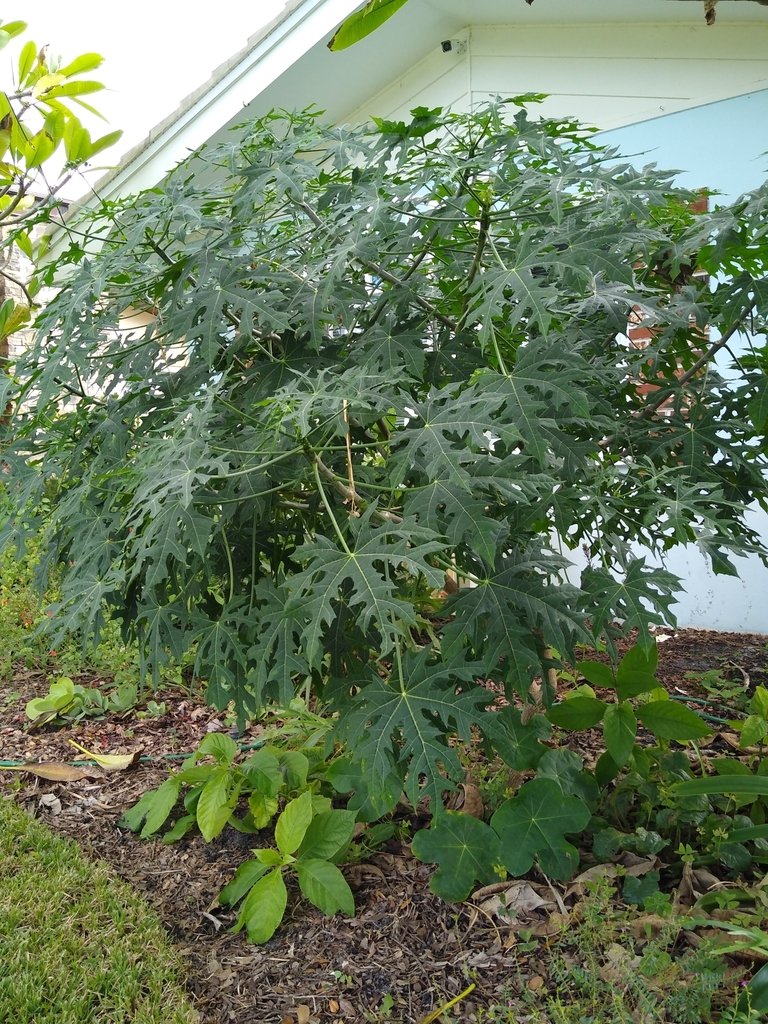Tree Spinach
Cnidoscolus aconitifolius
Family: Euphorbiaceae
HISTORY
Chaya is a very cool crop indigenous to the Yucatan Peninsula in Mexico where it has been a popular leaf vegetable among Mayan communities for thousands of years. Its natural range spans from northern Mexico and as far south as Peru. It spread throughout the Caribbean and into Florida via indigenous trade prior to European colonialism. Chaya was introduced to Asia and Africa via trans-Atlantic trade during the colonial period.
It’s pretty remarkable that this plant, which before selection was mostly poisonous and covered in stinging hairs, became domesticated as an edible crop. This crop is one of the many from the Americas that exemplifies the ingenuity of the indigenous people of the region.
DESCRIPTION
This is a large shrub that, in frost-free conditions, can grow up to 20’ or more. But most often it is pruned (being used for food) to a 5 or 6’ shrub. It is also frost-tender and this also limits how tall it can get in our region. The older limbs are woody but produce almost succulent new limbs loaded with glossy, dark green leaves. The foliage ranges from maple-like, to very divided leaves that are deeply lobed (see illustration below). In cold weather the plants can drop many or all of their leaves.
USES
There are four cultivated varieties of chaya represented in the illustration here: I. 'Estrella' II. 'Picuda' III. Chayamansa' IV. Redonda.' The main difference is the leaf shape and how deeply lobed the leaves are.
Chaya is a good source of protein, vitamins, calcium, and iron; and is also a rich source of antioxidants, however, raw chaya leaves are toxic as they contain a glucoside that can release toxic cyanide. Cooking is essential prior to consumption to inactivate the toxic components. In this, chaya is similar to cassava, which also contains toxic hydrocyanic glycosides and must be cooked before being eaten. Cooking in aluminum utensils can result in a toxic broth, causing diarrhea, so aluminium cookware should be avoided.
Young chaya leaves and the thick, tender stem tips are cut and boiled as a spinach. It is a tasty vegetable and is exceptionally high in protein, calcium, iron, and vitamin A. In fact, levels of chaya leaf nutrients are twofold to threefold greater than any other land-based leafy green vegetable. Chaya leaves have a possible antidiabetic effect.
Traditionally, leaves are immersed and simmered for 20 minutes and then served with oil or butter. Cooking for 20 minutes or more will render the leaves safe to eat. The stock or liquid in which the leaves are cooked may be safe for consumption also, as the cyanide is volatilized as hydrogen cyanide (HCN) during cooking. Here is a cool pdf of chaya recipes.
PRESERVATION
Leaves can be cooked and then dried in the sun or using a dehydrator. Grind the dried leaves into a powder and use in breads, smoothies, drinks, and sweets to provide a boost of nutrition. Leaves can also be frozen or canned for later use. Use a pressure canner if canning.
GROWING
Chaya is very easy to grow and only has one major issue in our region, which is the cold. Have a plant to protect this plant from frost, which can be accomplished with a very protected microclimate like a courtyard, or kept in a container that you can bring in on the cold nights (plants do well in large containers).
Grow in part sun for the best growth, though plants can take more sun with more regular water, and shady spots as well.
Water moderately, and provide good drainage. Try not to over-water plants in winter when they are semi-dormant.
Feed once or twice a year with a multi-purpose, organic fertilizer.
HARVESTING
Pluck leaves as you need. You may keep plants pruned so they stay at a height where you can reach the foliage. Pruning plants will also encourage more branching which means more leaves.
The flowers occur in summer. Photo by Aurelio Molina Hernández, iNatualist
Photo of the seeds, which retail the stinging hairs of the more wild plants. Photo by FRANCISCO MIGUEL FARRIOLS ESTRADA, iNaturalist
This variety is one of the more wild varieties with more entire leaves and residual stinging hairs. Photo by FRANCISCO MIGUEL FARRIOLS ESTRADA, iNaturalist
The Picuda variety with its deeply lobed leaves. Photo by chaseyb, iNaturalist
The estrella variety has a divided leaf but the lobes are much wider. Photo by salejandre, iNaturalist
The Redonda variety has maple-leaf shape. Photo by Neptalí Ramírez Marcial, iNaturalist









